
|
As the promontory where the fortress is situated is not easily accessible either
from sea or land it was not inhabited continually throughout the history. It was surrounded by city walls first during the Hellenistic era and later new additions were constructed according to the demands of the time.
The monumental fortress of Alanya is truly the sturdiest and the most splendid of all fortresses in Anatolia today. The oldest known inscriptions too, it may be assumed that the whole fortress was built by Sultan Alaaddin Keykubat ı between 1226-1232.According to the inscription on it, the octagonal structure known today as the Red Tower (Kızıl Kule) was the first structure built by the Seljuk's in Alanya and it is the key point of the fortress. The defense line that starts here, in accordance with the topography of the land ascends in a zigzagging manner although not always regularly. After a certain distance it joins a complex of buildings called Ehmedek, which was built, on top of a Hellenistic tower. The city wall, which turns southward after Ehmedek and descends, in order, to Adam Atacağı Cilvarda Burnu, Arab Evliyası Tower, Esad Tower and then by Tophane and Tersane, ends where it starts, at the red Tower. Since the land between the Red Tower and Ehmedek is not so steep, in order to slow down attacks from the north, curtain walls were built outside the main city walls, in many places ditches were dug in the bedrock at the first lien of defense against attacks. The first lien of the fortress must have been considered secure since no such defense elements were used. One-hundred-forty towers are seen on top of the city walls that stretch a total of 6400 meters. These walls and towers, built with stone and mortar, had embrasures, holes to pour out hot oil and ramps to facilitate the movements of the soldiers in the fortress. The fortress was entered through the arched main gates with inscriptions on them. There were also smaller auxiliary gates. Today, only a few of these gates are in good state of preservation. The fortress of Alanya, as observed on the map, may be divided into three sections based on the city walls and various defense lines. Dışkale (the outer Fortress) in the area surrounded by the walls that extend through Kızıl Kule, Ehdemek, Arab Evliyası, Tophane and then reach Kızıl kule again. Kızıl Kule, Tersane and Tophane are the most prominent Seljuk monuments in Alanya. Ortakale (the middle fortress) in the area surrounded by Ehdemek, Arab Evliyası and the walls of the outer fortress. Seljuk monuments such as the Akşebe Mausoleum, baths and a building complex know as Ehdemek, as well as Ottoman Monuments such as the Süleymaniye Mosque, the hostel, the marketplace, and a late Byzantine chapel called Arab Evliyası are located in the Middle fortress. Iç kale (the inner Fortress) located on the highest point in the northwestern corner, of the promontory is the last shelter and point of defense. The area surrounded by high walls resembles a falcon crest and it was used for military purposes Seljuk monuments like palaces of the sultans and other important people, military establishments, training schools, cisterns as well as a church lasted to the late Byzantine era are found in the Inner Fortress. There is also an interesting little corner know as Adam Atacağı.
|

|
THE RED
TOWER
|
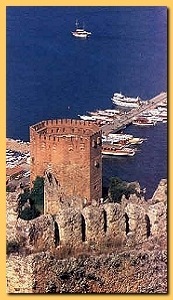 |
|
The 33-metre tall tower was built in order to keep the harbor under surveillance at all times.
The technique used in its construction, its floor plan and its construction, its floor plan and its durability make this monumental tower one of the most prominent Seljuk monument. The octagonal tower built on rocky terrain has a diameter of 29 meters. Local stone brought in from the vicinity and thick mortars were used in the construction of the first two stories of the tower and dark red baked clay brick was used in the construction of the upper stores. This durable thick mortar was used in almost all of the Seljuk towers. Although the stones in certain sections have crumbled down, the mortar still remains intact.
The tower was named after Sultan Alaaddin Keykubat when it was first built, but later it was renamed the red tower due to the red bricks used in the construction. Many architectural pieces dating back to the ancient times were used in its construction. Especially the ancient column shafts used horizontally in the construction of the facade give the tower an unusual appearance.
|

TERSANE
(THE SHIPYARDS)
|
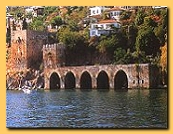 |
|
Situated to the south of the Red Tower, right by the sea, there is a covered building where the big warships of the age were built in complete security. After Sinop on the black sea coast, the Seljuk's used this Shipyard as a naval base and sailed the Mediterranean. Following the construction of these dockyard, Alaaddin Keykubat
I received the title "Sultan of the two seas "
The rectangular structure measures 40 by 57 meters and consists of vaulted galleries where ships were built. The galleries are connected to each other by four pointed-arches. It's facade and all the weight-carrying elements are built of large, cut stone blocks, and the vaults of baked bricks.
|

| THE DAMLATAŞ
CAVE
|
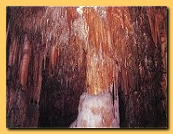 |
|
Located at the western foot of the Fortress of Alanya, the Damlataş Cave is one of those rare caves in Anatolia which is under management, it appeals to Turkish as well as foreign tourists since the air in the cave is beneficial to asthmatics, and it is easily accessible from the center of the city. It was discovered in 1948 quite by accident, it formed as semi-crystallized limestone from the Permian period of the Paleozoic Age was shaped by erosion over thousands of years. It is approximately 100 meters from the sea and in relation to below the entrance. There are many stalactites, stalagmites and columns decorating everywhere in the halls. Following the rumors that asthmatics benefited from breathing the air in the cave, scientists analyzed a sample of the air to verify the fact that the air was indeed beneficial to patients suffering from non-allergic asthma. They found that the air in the cave contains 10to 12 times more carbon dioxide than normal air and has 90 to 100 % humidity. Temperature in the cave is 22 C. Both the radioactivity and ionization in the cave may contribute to the benefits derived from breathing the air in the cave.
|

|
THE ALARA
FORTRESS
|
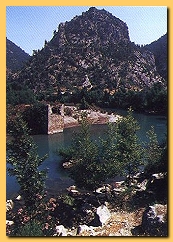 |
|
A little further from the Şarapsa Hostel, at the and of the 9 km long road that separates northward from the main road is the Alara separates northward from the main road is the Alara Stream which runs through a deep, narrow valley. On one side of the stream, on a rocky cliff stands the Alara Fortress. Behind the fortress, this is steep cliff down to the stream. The Alara stream, which originates between the mountains covered with green frosts runs at he foot of the cliff below the fortress and serpentines towards the sea.
|
 ALARAHAN ALARAHAN
(THE ALARA HOSTEL)
|
Alara Hostel was the second hostel after Şarapsa on the way from Alaiye to Antalya and Konya. It is an unusual Seljuk monument since it also served a religious function as a place where certain dervishes lived in seclusion. The rectangular structure measures 38 by 50 meters and except for its esteem facade, it is constructed of cut stones. Various signs identifying the master stonecutters are seen on these cut stones. Rectangular and triangular pillars support the three facades of the structure. The plain portal with a low arch, in the middle of the northern facade, is the entrance to he hostel. Above the entrance there is an inscription of six lines in Arabic. Relieves of two schematic lion heads decorate the inscription.
|
 HASBAHÇE
COTTAGE HASBAHÇE
COTTAGE
|
This cottage, which was organized as a resting and hunting place during if Alaaddin Keykubat, there are many ruins of villas, baths, cisterns, pool for the for the irrigation and surrounding walls. It is in the Hasbahçe quarter.
|
 SELJUKIANS
MADRASAH SELJUKIANS
MADRASAH
|
This madrasah, which was constituted by Alaaddin Keykubat during the year 1232 on a hill at Obaköy, is an example of the Seljuk's handmade arts and education institutes.
|

|
ŞARAPSA (SERAPSU)
INN
|
 |
|
This inn is a Seljuk's monument, constituted between the 1234-1246,There is also a small mosque at the east side of it .It is 15 km. Away from Alanya, on the road of Antalya.
|

|
SYEDRA
ANTIQUE
CITY
|
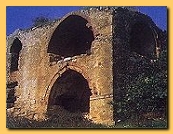 |
|
This city was constituted during the 3 Century B.C. and there are the ruins of baths, roads, grave with fresco signs and the ruins of a palace On the ground of the bath at the East or the cite ruins of mosaics. It is 8 km. Away from tours Alanya inside the Mahmutlar Town. You can reach until Mahmutlar Town by public taxis, and then continue by taxi or by a special from Alanya.
|
 İNCEKUM
FOREST İNCEKUM
FOREST
RESTING CAMPING
|
This is natural seashore 30 km. away from Alanya, on the road of Antalya where forests of pines reaches the sea with a shallow watered sea camping and picnic opportunities and beaches. The entrance is due to the payment. You can reach there Yeşilköy and Manavgat, by buses going to Antalya, or by taxi or by special tours.
|

ULAŞ
ROADWAY
RESTING CAMPING
|
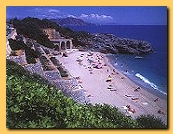 |
|
This is 5 km away from Alanya on the roadway of Antalya This is also a picnic place. The entrance is due to payment you can reach there by public busses by public busses going to Konaklı, Avsallar, Türkler, Türktaş, Yeşilköy and Manavgat, by buses going to Antalya by taxi or by special tours.
|

|
DAMLATAŞ
BEACH
|
 |
|
It is near the Cleopatra beach, going towards the West for about the entrance is free; the umbrellas and the beds are due to payment. There are sandwich buffets.
|
 EASTERN
BEACH EASTERN
BEACH
|
This beach continues for many kilometers from the city Centrum of Alanya to the East, towards Mersin .It is opened to the public. The umbrellas and the beds here are due to payment. There are
Sandwich buffets.
|
 DIM BROOK PICNIC
AREA DIM BROOK PICNIC
AREA
|
This is 15 km at the Northeast of the city. This is a beautiful picnic area with many trees omamanting untains and abundant waters. In addition, there are many restaurants where you can find alive trout fishes. You can go there by taxi or special tours.
|

|
SEA
CAVES
|
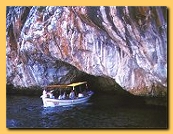 |
|
These are the caves located in the Southwestern side of Alanya peninsula and they have many natural and geological beauties. They have different names as Korsanlar (Pirates) Aşıklar (lovers), and Fosforlu Mağara (Phosphoric cave)
|
 HASBAHÇE
CAVE HASBAHÇE
CAVE
|
It is 4 km away from Alanya and 4-5 times lager than the Damlataş cave. This cave is not very well known yet.
|

|
DİM
CAVE
|
 |
|
Dim cave placed in the town Kestel of Alanya. It lies at the south side of the Dim valley.The highness counted from the sea is 232 meters. There are two parts of this cave. The left part is 360 m. and the right part is 50 meters.It's the second big cave in Turkey to be opened for visitors.
|
|